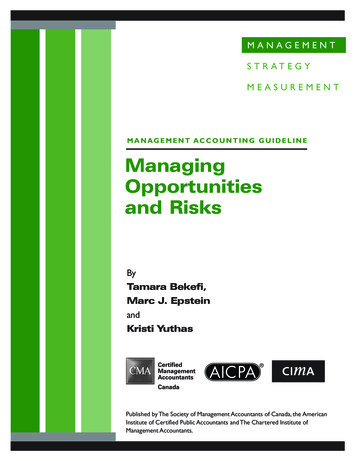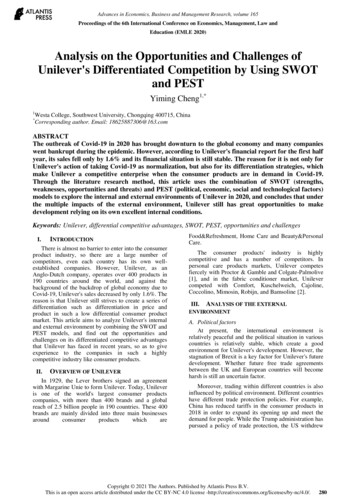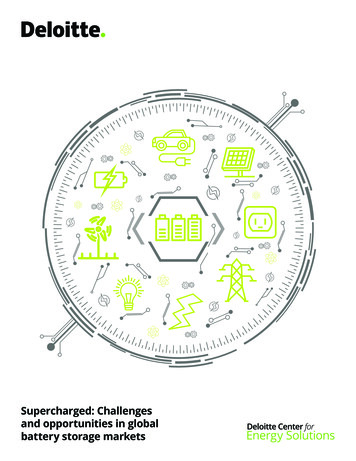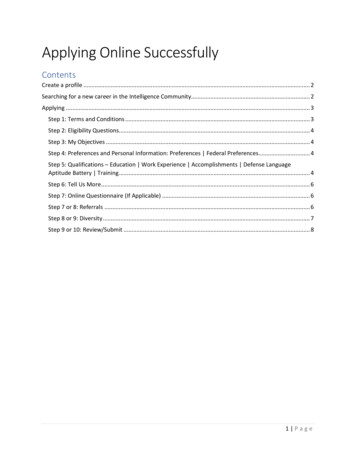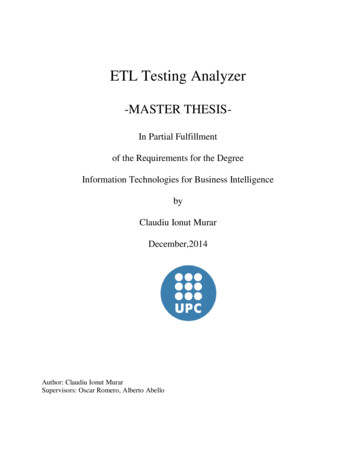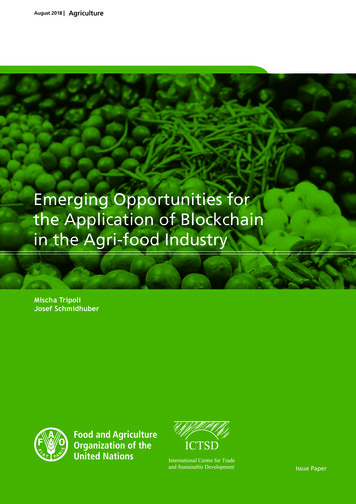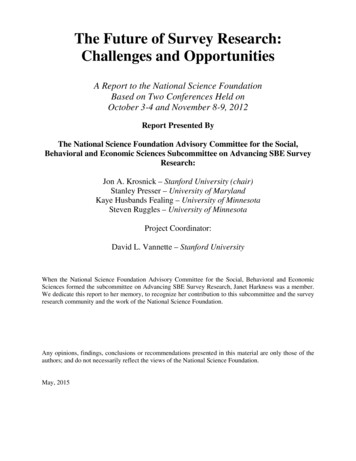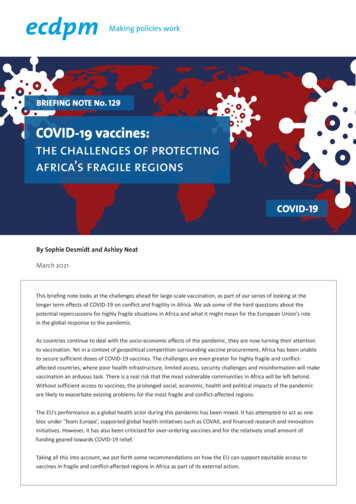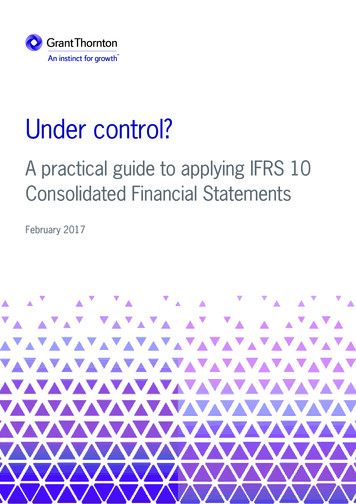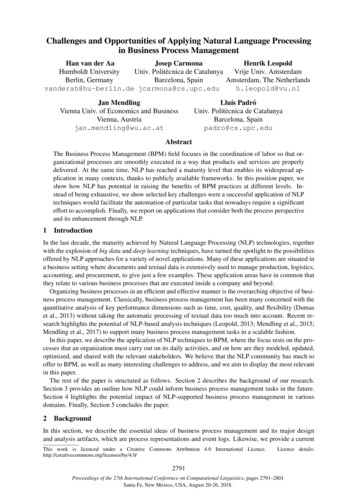
Transcription
Challenges and Opportunities of Applying Natural Language Processingin Business Process ManagementHan van der AaJosep CarmonaHenrik LeopoldHumboldt UniversityUniv. Politècnica de CatalunyaVrije Univ. AmsterdamBerlin, GermanyBarcelona, SpainAmsterdam, The Netherlandsvanderah@hu-berlin.de jcarmona@cs.upc.eduh.leopold@vu.nlJan MendlingVienna Univ. of Economics and BusinessVienna, Austriajan.mendling@wu.ac.atLluı́s PadróUniv. Politècnica de CatalunyaBarcelona, Spainpadro@cs.upc.eduAbstractThe Business Process Management (BPM) field focuses in the coordination of labor so that organizational processes are smoothly executed in a way that products and services are properlydelivered. At the same time, NLP has reached a maturity level that enables its widespread application in many contexts, thanks to publicly available frameworks. In this position paper, weshow how NLP has potential in raising the benefits of BPM practices at different levels. Instead of being exhaustive, we show selected key challenges were a successful application of NLPtechniques would facilitate the automation of particular tasks that nowadays require a significanteffort to accomplish. Finally, we report on applications that consider both the process perspectiveand its enhancement through NLP.1IntroductionIn the last decade, the maturity achieved by Natural Language Processing (NLP) technologies, togetherwith the explosion of big data and deep learning techniques, have turned the spotlight to the possibilitiesoffered by NLP approaches for a variety of novel applications. Many of these applications are situated ina business setting where documents and textual data is extensively used to manage production, logistics,accounting, and procurement, to give just a few examples. These application areas have in common thatthey relate to various business processes that are executed inside a company and beyond.Organizing business processes in an efficient and effective manner is the overarching objective of business process management. Classically, business process management has been many concerned with thequantitative analysis of key performance dimensions such as time, cost, quality, and flexibility (Dumaset al., 2013) without taking the automatic processing of textual data too much into account. Recent research highlights the potential of NLP-based analysis techniques (Leopold, 2013; Mendling et al., 2015;Mendling et al., 2017) to support many business process management tasks in a scalable fashion.In this paper, we describe the application of NLP techniques to BPM, where the focus rests on the processes that an organization must carry out on its daily activities, and on how are they modeled, updated,optimized, and shared with the relevant stakeholders. We believe that the NLP community has much tooffer to BPM, as well as many interesting challenges to address, and we aim to display the most relevantin this paper.The rest of the paper is structured as follows. Section 2 describes the background of our research.Section 3 provides an outline how NLP could inform business process management tasks in the future.Section 4 highlights the potential impact of NLP-supported business process management in variousdomains. Finally, Section 5 concludes the paper.2BackgroundIn this section, we describe the essential ideas of business process management and its major designand analysis artifacts, which are process representations and event logs. Likewise, we provide a currentThis work is licenced under a Creative Commons Attribution 4.0 International /Licence details:2791Proceedings of the 27th International Conference on Computational Linguistics, pages 2791–2801Santa Fe, New Mexico, USA, August 20-26, 2018.
perspective on NLP and how it can be oriented towards improving BPM in a general setting.2.1Requirements of Business Process ManagementBusiness process management is concerned with various management activities that are related to business processes (Dumas et al., 2013). In line with Mendling et al. (2017), we describe three levels ofbusiness process management as illustrated in Figure 1. The top level called multi process managementis concerned with the identification of the major processes of an organization and the prioritization ofthese. The middle level is concerned with the management of a single process along the classical BPMlifecycle (Dumas et al., 2013) including the steps of discovery, analysis, redesign, implementation andcontrolling. The level of process instance management deals with planning the tasks of a process, executing them, monitoring them, and potentially adapting the instance if required. All the three layersmake use of business process models and event data.Multi ss s ssInstanceMonitoringFigure 1: Three Levels of Business Process Management (taken from (Mendling et al., 2017)).2.2Process RepresentationsA variety of representation formats can be used to capture process information in informational artifacts (Wolter and Meinel, 2010), including process models (Davies et al., 2006), natural language descriptions (Phalp et al., 2007), spreadsheets (Krumnow and Decker, 2010), and checklists (Reijers et al.,2017). The representation format used to provide process information to users should be well-suited forits particular purpose, in two ways: A format should convey its informational content in a useful mannerand the intended users should be able to appropriately understand the received format (van der Aa, 2018).Representation formats emphasize different aspects of business processes. This means that the choicefor a certain representation format depends on the intended focus of an informational artifact. For instance, natural language text can be very useful to provide process participants with detailed insightson how to perform complex tasks (Baier and Mendling, 2013). However, for a process participant whoneeds to be sure that all necessary steps are performed, a checklist might be more useful. This later format could be more suitable because it emphasizes the information that is of primary importance for thatpurpose. Furthermore, process models have been found to be better suited to express complex executionlogic of a process in a more comprehensive manner than natural language (Mendling, 2008, p.23).2792
(2) A member of the sales department can thenreject or accept the order for a customized bike.ReceiveorderAcceptorder?NoYesInform S&Edepartment(4) If the order is accepted, the order details areentered into the ERP system.Enter detailsinto ERPsystemx(3) Then, the storehouse and the engineeringdepartment (S&E) are informed.ReservepartYes(5) If a part is available, it is reserved.No(6) If it is not available, it is back-ordered.Availablein-house?(7) This procedure is repeated for each item on thepart list.(8) In the meantime, the engineering departmentprepares everything for the assembling of theordered bicycle.(9) If the storehouse has successfully reserved orback-ordered every item of the part list and thepreparation activity has finished, the engineeringdepartment assembles the bicycle.BackorderpartAny part leftunchecked?NoYes(1) Whenever the sales department receives anorder, a new process instance is created.SelectuncheckedpartPrepare forassemblingAssemblebicycleFigure 2: A textual and a model-based description of a bicycle manufacturing process.It is also important that users of an informational artifact are able to work well with the employedrepresentation format. The ability of users to do so can depend on their familiarity and preferenceswith respect to different formats. Research by Figl and Recker (2016) shows that people prefer differentprocess representation formats depending on the application purpose and on the cognitive style of theuser. For example, some participants were found to prefer textual descriptions over process models,whereas others preferred models over text for the same purpose. The influence of user preferences onthe choice for model or text-based process representations is also recognized by Recker et al. (2012) andChakraborty et al. (2010).Figure 2 shows an example of two different process representations, namely a process model and atextual process description. On the left- hand side, we observe a textual description, which comprisesnine sentences. On the right-hand side, a corresponding model-based description can be seen, modeledusing the Business Process Model and Notation (BPMN). The model contains eight activities, whichare depicted using boxes with rounded edges. The diamond shapes that contain a plus symbol indicateconcurrent streams of action; the diamond shapes containing a cross represent decision points. The grayshades suggest correspondences between the sentences and the activities of the process model.2.3Event Data for the Footprints of Process ExecutionsInformation systems supporting processes in organizations enable the persistent storage of process executions, in large log files denoted event logs. Event logs can be seen as a tabular representation of allthe necessary events for a process execution (denoted as case) to be accomplished. Table 1 providesan excerpt of an event log for the bicycle manufacturing process used in this paper. Three importantelements (columns in the table) that identify an event (row) in an event log are: i) the case ID (to identifythe process instance or case executed), ii) the timestamp (to identify when the event was executed), andiii) the activity name (to identify the task performed). Extra information in form of additional columnsmay exist, to provide contextual information to the execution of events. For instance, in the table threecases appear: case 1 denotes an order that was rejected, case 2 denotes an order that was completelyexecuted till the bicycle assembly, and case 3 is ongoing.In contrast to the process representations described in the previous section, event logs describe thereality, i.e., the recorded events witnessing all process instances stored in the information system. Wewill refer to event logs in this paper in particular parts, to highlight the importance to relate observed and2793
Event12345678910Case ID1222222232ActivityReceive OrderReceive OrderInform S&E dept.Enter details ERPPrepare for assemb.Reserve partSel uncheck. partBackorder partReceive OrderAssemble bycicleTimestamp10-04-2015 9:08am10-04-2015 10:03am10-04-2015 10:05am10-04-2015 10:09am10-04-2015 10:10am10-04-2015 10:12am10-04-2015 11:12am10-04-2015 12:06am10-04-2015 13:18am11-04-2015 Storeh.SalesEng.Add. �Table 1: Part of an event log for the bicycle manufacturing process.modeled behavior.2.4NLP Capabilities and FrameworksThere are several existing NLP technologies that can be more or less straightforwardly applied to BPM.As illustrated in Fig. 2, a textual description of a bussiness process is a text where several actors arementioned, and their actions and interactions described. Thus, out-of-the-box analyzers can be used tostructure the content of the text. Tools such as Stanford Core (Manning et al., 2014), FreeLing (Padró andStanilovsky, 2012), Apache OpenNLP1 , or NLTK (Bird et al., 2009) can be used to extract predicates andinvolved actors via SRL, perform WSD to identify domain objects that may be mentioned using differentwords, solve coreferences to decide which of the mentioned actors correspond to the same entity, decidewhich order the described actions must follow or whether there are choices or loops, etc.However, existing analysis pipelines are still below optimal performance, specially in the more semantic tasks (WSD, coreference, SRL, temporal relation extraction, etc.) and on an unrestricted domain(process descriptions may report organization processes in a huge range of sectors –health, education,banking, manufacturing, etc).So, several challenges for NLP researchers can be found in the application to BPM: Improvement of the performance of individual analyzers, specially at the semantic/pragmatic level(e.g. in Figure 2, the mentions the sales department in sentence (1), and a member of the salesdepartment in sentence (2) are actually referring to the same actor in the process, but a coreferencesystem would consider them two different entities). Domain adaptation methods to tune generic NLP processors to deal with process descriptions ina specific organization or sector. This may require the creation/acquisition of tailored ontologiesthat help specifying with the right terms important parts of the process and relations among theserelevant domain concepts. Definition of new tasks, such as the detection of exclusivity, parallelism/concurrency, decisionpoints, or iteration of tasks described in the text (e.g. the phrase this procedure or the marker inthe meantime in sentences (7) and (8) in Figure 2 are ambiguous with respect their antecedent, andeach interpretation leads to different formal models). Use of world knowledge to improve the results (often some steps or relations among tasks areomitted because the reader is assumed to be able to understand it using common sense or domainknowledge, such as that a payment happens always after an invoice is emitted, or that a bicycle cannot be assembled until all required parts have been obtained).1https://opennlp.apache.org2794
Information extraction from event logs. Among others, interesting directions is the elicitationthrough NLP techniques of process steps for loosely specified processes, projecting event logs forevents at a given granularity level, etc.3Expanding BPM Capabilities through NLPIn this section, we provide interesting research directions based on incorporating/extending NLP capabilities in the three levels described in Fig. 1.3.1Multi-Process ManagementMulti process management is concerned with the identification of the major business processes of acompany and the prioritization of these processes. The overall landscape of business processes is oftenrepresented as a process architecture, which is stored in a business process repository. Large multinational corporations often maintain several thousand process models in such repositories.Prior research on multi process management has focused on repository management, building on techniques for determining process similarity (Dijkman et al., 2011), automatically matching business process models (Weidlich et al., 2010), and other querying techniques (Leopold et al., 2017). Several concepts have been proposed on top including automatic refactoring (Weber et al., 2011) including harmonization of terminology (Pittke et al., 2015), automatic service derivation (Leopold et al., 2015), semanticsearch (Thomas and Fellmann, 2009) and merging business process models (Rosa et al., 2013).Several challenges remain in this area including the following (Mendling et al., 2015). First, the availability of a business process repository bears the potential to discover an overarching formal ontology thatcaptures the full spectrum of operations of a company. Second, content captured in the repository mightbe automatically categorized, for example with respect to documentation standards such as ISO:9001.Such tasks require the application and adaptation of existing NLP techniques in this specific context.3.2Process ManagementSeveral important challenges need to be tackled so that tasks in the process model management stage ofFig. 1 such as discovery, analysis, redesigning and controlling of processes are excelled at organizations.In this section we focus on providing examples of key enablers for tackling these challenges.The discovery of processes concerns the identification of the main processes in an organization, andthe corresponding elicitation into a (graphical) notation such as BPMN, which facilitates the communication between the stakeholders involved in a process. In practice, this phase is often implemented usingworkshop meetings, requiring quite significant efforts to materialize a process model from the conversations arising in these meetings. An alternative is the use of process mining techniques, which enable, forinstance, the automatic discovery of process models from event logs (van der Aalst, 2016).NLP techniques can be applied at very different granularities to boost the discovery of precise processmodel descriptions of a process. Among the available techniques, we highlight the most disruptive ones: Transform textual descriptions into process models: The creation of process models consumes upto 60% of the time spent on process management projects. This is a paradox, because there areoften extensive textual process documentations available in organizations. Therefore, automaticallytransforming textual process descriptions to process models represents a particularly attractive usecase. Several techniques have been developed for this purpose (Friedrich et al., 2011). These usetailored NLP techniques in order to identify actions, e.g. ”The sales department receives an order”,and their inter-relations, e.g. “If the order is accepted, the order details are entered into the system.These extracted components represent the foundation for the generation of a process model froma text. However, a number of challenges still remain for this endeavor. For instance, techniquesmust be able to identify sentences that provide contextual information, rather than describe processsteps. Furthermore, the inherent ambiguity of natural language can lead to different interpretationsregarding the process that is described (Van der Aa et al., 2016). Translate process models: Sometimes the same process (e.g., the admission process to enroll in auniversity) is defined multiple times (e.g., several universities in several countries, or a worldwide2795
company that applies a given process across several countries). In these contexts, it is crucial tohave multilingual support for translating a given process model description (in any form) into atarget language. For the case of process model graphical descriptions (e.g., BPMN), translationof individual model elements may be sufficient to obtain a translated description with a certainquality, since the structure of the process is retained. In contrast, translating textual descriptions ofa process may become more challenging, due to the particularities each language has in describingcertain constructs. Text Annotation and Inference: In the scope of the two previous use cases (from text to processmodels, process model translation), the difficulty of generating the output would be significantlyalleviated if the text was correctly annotated, reducing the noise introduced by automatic NLP tools.One can envision that, in the narrow scope of the description of a process one could define a limitedset of template annotations that address particular perspectives (control-flow, roles, data, amongothers) which can help a user to (partially) annotate a textual description of a process. Nowadays,there exist advanced tools for text annotation such as Brat (Stenetorp et al., 2012). From annotatedtextual descriptions of a process model (e.g., control-flow annotations establishing relations betweentwo sentences), inferences can elicit new relations that can be used to have a more precise andrefined descriptions (e.g., transitive closure of the relations). The same annotations could be usedas training data to improve or adapt automatic languages analyzers tuned to this particular tasks.The analysis phase is oriented towards finding weakness of current process model candidates. Thisphase can also be significantly improved by a tailored used of NLP techniques in particular situations.We describe here some examples of challenges to face in order to materialize such improvements: Verify semantic correctness and completeness: The semantic quality of process models is crucial tothe proper understanding of business processes. A number of techniques aim to verify this qualityin an automated manner. These techniques achieve this, for example, by detecting and/or correctinginconsistent use of terminology (Koschmider and Blanchard, 2007) or violations of labeling conventions (Becker et al., 2009; Leopold et al., 2013a; Van der Vos et al., 1997). Others aim to improvemodeling quality by detecting common modeling errors (Gruhn and Laue, 2011) or ambiguouslylabeled activities (Pittke et al., 2015; Pittke et al., 2014). Calculate consistency between process model and text: As mentioned before, keeping different process descriptions helps improving the knowledge about processes across an organization. However,as processes evolve continuously, it is necessary to detect inconsistencies between process descriptions in order to ensure the expectations for process outcomes are the same for every actor (van derAa et al., 2017). The challenge here is to find correspondences between sentences in the text andelements in the process model, and warn in case important parts are not mapped. This requiresa respective NLP analysis in both process descriptions and computation of similarities while considering the different discourse level, ambiguities, anaphora/coreference in the text, among others.Fig. 2 shows an example of a possible mapping between the textual and the model description ofthe process.In the redesign phase, issues detected in the previous phase are amended by a refactoring of the processmodel, so that the to-be model is produced. NLP-based techniques can also be oriented towards this goal: Fine-tuning of semantic abstraction levels: Larger sets of process models, so-called, process modelcollections, are typically hierarchically organized. This means, that process models on higher levelprovide a rather course-grained view of a process, while process model on a lower level providea more detailed view. One of the major challenges in this context is to make sure that processmodels on the same level in the hierarchy also have a comparable level of abstraction. First worksthat addressed this problem have used rather simple linguistic measures, such as the specificity ofindividual words, to determine whether two process models provide a comparable level of abstraction (Leopold et al., 2013b). However, a solution that assesses the abstraction level based on theconveyed semantics is still missing.2796
Process description semantic auto-completion: Process descriptions may be semantically incomplete. Ideally, a process description should be semantically complete before it is used. There aredifferent situations where a process description could be auto-completed. For instance, imaginethat the second sentence in the process description of Fig. 2 is: A member of the sales departmentmust check the order for a customized bike and decide its acceptance. Semantically, this sentencesuggests that there is also the possibility to reject the order of a bike. However, it is not explicitin the textual description what to do if the result of the check is negative. Warning about this incompleteness of the textual description may help improving it, by reducing its ambiguity. A similarsituation may occur in the graphical description in the right, i.e., if the arc labeled No (and the targetgateway) are missing in the process model description in Fig. 2. Some techniques are available forthis task (Hornung et al., 2007), but there are still several challenges, mainly on the automation ofthe problem.In the controlling phase, apart from the traditional monitoring techniques that focus on checking theperformance and conformance requirements, Natural Language Generation techniques can be applied tokeep different descriptions of the process available: Transform process model to textual descriptions: Not all stakeholders are able to understand aprocess model descriptions like the one shown at the right of Fig. 2. However, virtually everyonecan understand the textual description shown at the left. Recent studies on process understandabilityadvocate for the use of several descriptions in order to boost the understanding (Ottensooser et al.,2012). Hence, generating textual descriptions of processes that complement formal ones helpsensuring different stakeholders will have the same expectations for a certain process (Leopold et al.,2014), and NLG is a good fit for this task. There are two main challenges associated with this task.First, we need to properly infer which words from the short process model labels refer to verbs andwhich words refer to nouns, and due to the shortness of the labels and the lack of a proper sentencesstructure (e.g., consider the label Order reservation) this is a non-trivial task which may requiredomain knowledge. Second, parallel behavior as well as choices from the process model have tobe communicated using a sequence of sentences, without compromising the ability of the reader tocomprehend the process semantics.3.3Instance ManagementManaging the execution of a single process instance (e.g., a particular order for manufacturing a bicyclein the process of Fig. 2, e.g., case 2 of Table 1) is the primary objective of the bottom level of BPM.There exists a significant amount of research from the last years about conversational systems (Mottet al., 2004), ultimately implemented as conversational bots or chatbots. Now let us assume that conversational systems are trained to support the execution of business processes. The ultimate goal would beto allow stakeholders of the process to navigate through it by means of querying a dialog system. Forinstance, for the process described in Fig. 2, a new worker may have doubts on what to do after a neworder is received. A tailored conversation system may come into rescue, by first describing her what arethe formal requirements for an order to be accepted. Then, when these requirements have been evaluatedby the worker, it will communicate back to the dialogue system the outcome of the evaluation (acceptedor not), and the dialogue system will provide the next step correspondingly (in case of the order beingaccepted, to inform the engineering department; in case of the order being rejected, finish the process).The challenge here is how to build useful conversational systems when a description of the process isavailable.In general, BPM tailored conversational systems may incorporate important NLP features like semantic understanding, context resolution, NLG, among others.44.1ApplicationsEducationThe possibility of transforming a formal process description (e.g., a BPMN like the one on the right inFig. 2) into a text (Leopold et al., 2014), or vice-versa, as well as the ability to align a textual and a formal2797
description of a process (Sànchez-Ferreres et al., 2017) opens the door to a range of educational applications for modeling students (e.g. Computer Science or Business students that need to learn to formalizea process): For instance, the model created by a student can be automatically compared to the text givenas statement, not only for automatic grading, but also to provide feedback regarding missing/redundanttasks or inconsistent paths in the control flow. Also, an initial model automatically generated from textcan be given to the student to complete or correct.4.2TroubleshootingAn important application domain for ensuring the correct execution of a process in a organization isthrough tailored dialogue systems. An example of this is chatbot-aided troubleshooting (Acomb et al.,2007), where artificial agents are used to complement human operators in contact centers. So far, knowledge representation in such chatbots comprises several components like natural language understandingand/or generation, together with a planner that encompasses the possible reactions to provide (Thorne,2017). The incorporation of process descriptions may help into attaining a more precise dialogue system,so that the planning of the dialogue is done under the constraints of the process, and that the agent canbetter assist the human in following the appropriate steps.4.3RegulationsNon-compliance represents a risk for many organizations. According to a recent study by ThomsonReuters, non-compliance may even represent a possible cause of bankruptcy, also for the so-called “behemoths” in the financial sector (English and Hammond, 2014). Recognizing the risk that is associatedwith non-compliance, organizations in a wide range of domains are stepping up their spending in orderto ensure their compliance with laws, regulations, and procedures. In this context, automated compliancechecking techniques that consider the process model and the event log play a crucial role thanks to theirability to automatically identify compliance violations (Accorsi and Stocker, 2012; Van der Aalst et al.,2010). For this reason, numerous approaches have been developed to perform this task (Van der Aalst etal., 2012; Weidlich et al., 2011; Awad et al., 2008). While the majority of such techniques require theallowed process behavior to be specified in formal models, such as process models or business rules, recent advances of NLP in the context of BPM overcome this restriction. In particular, a technique (van derAa et al., 2018) has been developed that can perform compliance checks on the basis of textual processdocumentation. This technique employs probabilistic methods in order to deal with the inherent ambiguity of natural language, which can cause uncertainty about the truly allowed process behavior specifiedin a text.4.4HealthcareElectronic health records (ERHs) contain detailed information of patients. They can and have been usedfor monitoring adherence to clinical guidelines. There has been several studies on how using th
and its enhancement through NLP. 1 Introduction In the last decade, the maturity achieved by Natural Language Processing (NLP) technologies, together with the explosion of big data and deep learning techniques, have turned the spotlight to the possibilities offered by NLP
